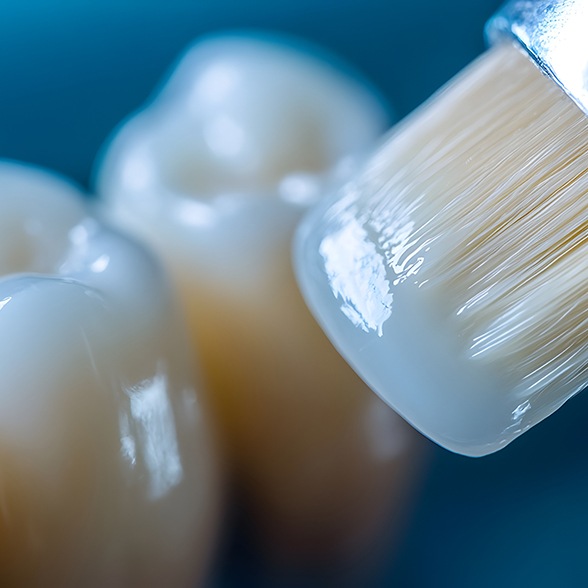Dental Sealants – Chesterfield, MO
Greater Protection for Hard-to-Reach Teeth
As children grow, their brushing habits begin to improve. They no longer find it difficult to clean all parts of their mouth, including those once hard-to-reach areas, like their molars and premolars. However, while your child is still young, they may struggle to clean these teeth well enough to avoid dental decay and cavities. To provide better protection, Dr. Sedighi and our team are pleased to provide a safe and effective form of preventive care – dental sealants in Chesterfield. Call us today to discuss your child’s need for treatment and how this unique service can ensure a healthier smile.

Why Choose Homer Sedighi, D.M.D. for Dental Sealants?
- Licensed Pediatric Dentists on Staff
- Select Saturday Dental Appointments Available
- Caring & Friendly Dental Staff
What Are Dental Sealants?

Dental sealants are a protective form of treatment that is designed to prevent cavities and dental decay from forming. As a clear, biocompatible material that is applied to the chewing surfaces of molars and premolars (located toward the back of the mouth), the plastic coating creates a strong barrier between the enamel and any bacteria or harmful particles that might try to penetrate.
Back teeth have various pits and grooves that make it easy for debris to become trapped; however, with dental sealants, your child’s teeth can remain safeguarded and cavity-free for up to 10 years.
How Are Dental Sealants Placed?

The process of having dental sealants placed is quick and easy. When your child arrives for their regular dental checkup, one of our licensed pediatric dentists will give their teeth a thorough cleaning before painting the sealants on their back teeth. Using a curing light, the material will harden and create a solid barrier. This should not cause any problems with your child’s bite, but we will make sure to have them bite down to check for comfort. If additional adjustments are required, we will make them at this time.
There is no need for anesthesia or sedation when applying dental sealants – it’s a painless method of treatment!
Who Should Get Dental Sealants?

According to the American Dental Association (ADA), children between the ages of 5 and 7 can benefit from dental sealants the most, as well as those who are 11-14 years of age. The reason is that these age ranges tend to have new teeth erupting (i.e., six-year molars, back molars, etc.). Ensuring their protection while your child hones and refines their brushing skills can be highly beneficial in keeping their smile cavity-free during this time.
You are always welcome to ask our team about your child’s need for dental sealants. We will be happy to take a look and provide our recommendation during their next visit.
Dental Sealant FAQs
What Are Dental Sealants Made From?
Dental sealants are made of plastic polymers that are safe for the body. This material comes in liquid form, so it can be painted onto the teeth. Next, it is cured with a UV light until it reaches a hardened state. This process of applying dental sealants takes a few minutes for your child’s dentist to apply to each tooth.
Are Dental Sealants Safe?
Dental sealants are considered safe. The material used is safe for the human body and the chances of a sealant coming off and causing any harm is very low. In rare occasions, someone may have a sensitivity to materials used, but all allergies and other medical considers will be discussed before your child’s treatment. Dental sealants can help to prevent your child’s risk of tooth decay – the most common chronic childhood disease.
How Long Do Dental Sealants Last?
Dental sealants are highly recommended for numerous reasons. This includes the fact that they can be applied once and offer protection against cavities for many years. According to the Centers for Disease Control and Prevention (CDC), dental sealants can protect against 80% of cavities for up to 24 months but continue to offer 50% protection for up to four years after being placed.
Are Dental Sealants Necessary?
According to the American Dental Association, approximately half of children between the ages of 6 and 19 have had sealants. This preventive measure is crucial for children whose permanent teeth have erupted. When sealants are placed, they protect the chewing surfaces of your child’s back molars from decay and cavities.
Do Dental Sealants Hurt?
Placing a dental sealant isn’t painful or even uncomfortable for your child. After cleaning your child’s tooth to make sure that it is free of plaque and debris, they will paint the sealant onto the tooth enamel. This sealant can be clear or white in color, so it won’t be noticeable to others. Each tooth only takes a couple of minutes but can help to set your child’s smile up for success for a lifetime!
Can Dental Sealants be Placed Over Cavities?
We generally don’t recommend this. Placing a sealant on an existing cavity could actually make the situation worse by preventing us from being able to properly repair the tooth decay. If your child only has early warning signs of potential decay, then we might be able to apply a sealant to the affected tooth. Otherwise, it’s best to treat the cavity with a crown or filling first!
Does Dental Insurance Cover the Cost of Dental Sealants?
Most dental insurance plans cover 100% of the costs for preventive dental care. This often applies to biannual checkups and cleanings but could very well include dental sealants for patients under the age of 18. Since every plan is a bit different, though, it’s best to check in with your dental insurance provider or one of our friendly team members to confirm your exact coverage.
Should My Child Still Brush and Floss After Getting Sealants?
Yes! Dental sealants are effective at helping to prevent cavities, but they’re only part of the equation. If your child doesn’t brush and floss on a regular basis, they could still experience tooth decay. Make sure that they brush their pearly whites with a soft bristled toothbrush twice daily and use floss at least once per day.
Is It True that Dental Sealants Contain BPA?
Yes, but dental sealants only contain very trace amounts of BPA. This chemical is used in many plastics and resins, which, as you might have guessed, are in many commonplace items these days. Receipt paper, cosmetics, and plain ‘ol dust particles are just a few things that actually have more BPA than dental sealants! Rest assured, the amount of BPA used in sealants won’t negatively affect your child.
Can Dental Sealants be Removed?
Yes they can, and there are a couple of reasons why we might recommend doing so:
- Extensive wear and tear. Dental sealants do wear down over time, so sometimes they need to be removed and replaced with fresher, more effective sealants.
- Future dental work. If your child needs some dental work like orthodontics later in life, their sealants might interfere with the treatment process.
- Patient preference. Some patients simply prefer to have their sealants removed. Sometimes this is for personal reasons, and other times their dental needs change.